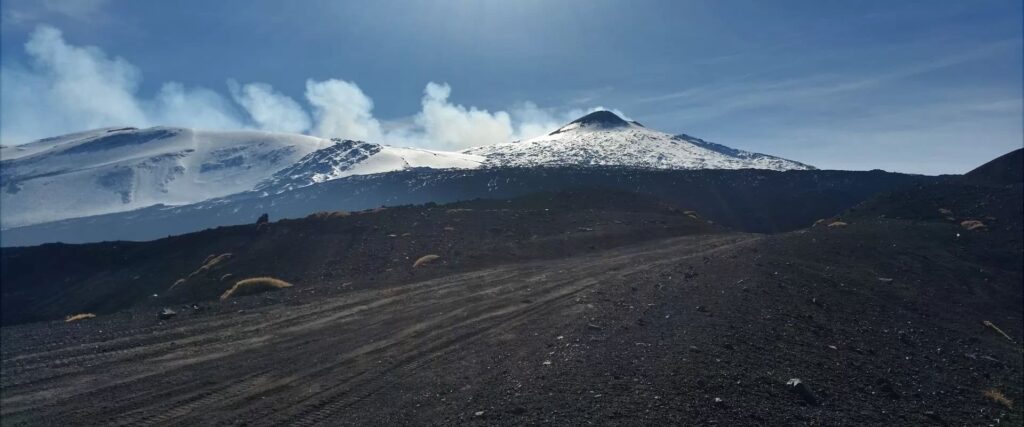Etna National Park, North side
We start from the north area of the volcano along the man-made ring of the so called “wine road”.
Linguaglossa is a small village situated in on the Etna Nord side. Well known for its production of Etna wines and typical Sicilian foods like hazelnut.
From here we take the Mareneveprovincial road, the only access road to the entire north side of Etna. The road climbs up the slopes of the volcano, crossing old paths and donkey trails now and then; the area is very varied, you drive through old lava flows that gradually give way to centuries-old forests.
Challenging trekking to the Valle del Bove & the most beautiful cave of Etna
Pineta (pine forest) Ragabo
As we head south, towards the summit zone, we come across the centuries-old Ragabo pine forest, the largest area of larch trees in Sicily. The wood was probably already used by the Romans for shipbuilding: and since this coniferous species is very rich in resin, the resin was also collected and used to seal the hulls of ships.
Unknown North Side: Tour through Lunar Landscapes and Green Forests
The Lava Front of 2002
At an altitude of about 1,100 m, we leave the road and take a path that leads to the lava front of the 2002 eruption. Here, as we stand in front of this huge mass of stone, even though it has long since become hard and cold, one can figuratively imagine what destructive forces nature can have. You can almost feel the power of a lava flow! The eruption covered a distance of about 13 kilometres in the short period of 10 days and fortunately decided to end its course there.
The caves on the north side of Etna: Grotta Corruccio
We continue up to 1395 m and start a new adventure; a short walk into the forest and we enter a secret of the mountain: we visit the lava tunnel Grotta di Corruccio, one of the approximately 190 lava tunnels scattered on Etna. Discovering what is hidden beneath the hard volcanic surface, we leave the surface and head into the twists and turns of the mountain to explore its hidden secrets.
These lava tunnels are formed during eruptions by the flow of boiling hot, still liquid lava, between 1,100 and 700°C. As the lava flows through, the outer layer cools and hardens, forming a kind of shell (crust) that, when cooled, allows the lava that continues to flow inside to maintain a stable temperature. The lava remains hot and liquid, sometimes for kilometres, and continues to flow until it empties the outer shell and forms a cavity. And a new cave emerges.
Piano Provenzana
Our journey continues through the Pineta Ragabo until we cross a lava tongue that literally splits it in two. We meet once again the 2002 lava flow and follow it upwards until the ski station at 1800 mt a.s.l. It is the lava flow from 2002 again. We drive along it until we reach the place, at 1,800 m, where the ski lift is located.
We are in Piano Provenzana, where the asphalt roads end. From here you can only continue on foot or with special off-road vehicles.
From here on we follow and cross the lava fields and craters of the great button line of the 2002 eruption up to the last eruptive cones formed at about 2400 m above sea level.
We also pass by the craters that were formed in 1809 along the same fault, one of the most active on Etna, the Pernicana Fault, now also known as the Northeast Rift. This fault causes deformations of 2 to 4 cm per year.
Piano delle Concazze and “Pizzi Deneri” Volcanological Observatory
We drive even further on the bare lava, the vegetation becoming increasingly bare, towards the north-eastern crater. When we reach Piano delle Concazze, we can see the observatory of “Pizzi Deneri” (2,847 m).
We leave the vehicles and have the feeling that we are on the roof of the world, if it weren’t for the majestic giant towering over us: the North-East Crater.
From the top of Pizzi Deneri, it is possible to admire the ski area and the entire north-eastern slope, a large part of north-eastern Sicily up to the Peloritanian mountains, the coasts of Calabria and towards the south the Löwental – Lion Valley and of course the summit craters with the (formerly) highest, directly in front of us, the North-East Crater.
As we head back downhill towards the ski lift, we have the opportunity to see the craters that formed in 1809 and some of the 2002 eruption cones up close. If we are lucky, we can see and touch the vapours rising from the hot interior of the volcano.
With this excursion we saw one of the newest and most majestic formations of Etna.
Until the next adventure!
We marvel at the huge main craters and the Valle del Bove at close quarters!

